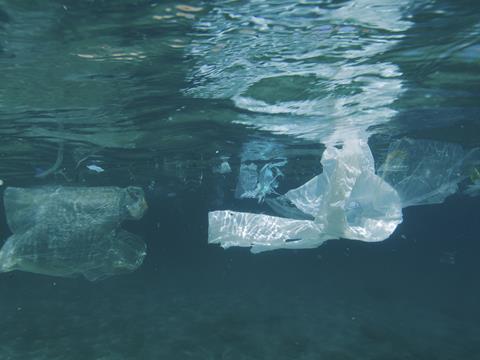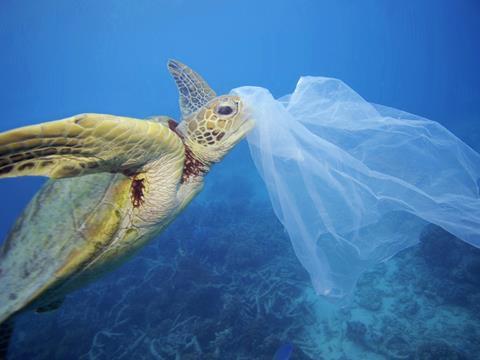
Quite rightly, packaging looms high both on the political agenda and in public concerns. There is intense pressure to act urgently on the issue of packaging waste, in particular plastic waste, in the face of increasing evidence of its grave impact on the environment. Sometimes the popular ‘case for the prosecution’ against packaging can be simplistic and involve calls for measures that would lead to disastrous unintended consequences. On the other hand, complacency is inexcusable. We believe it’s important to listen in good faith to the perspectives from outside the industry bubble. Perhaps their views need to be qualified and balanced – but first we have to engage. Louise Edge, senior oceans campaigner for Greenpeace UK, sets out her challenge to packaging. Tim Sykes listens.
Tim Sykes:
Could you set out the impact of packaging waste on the environment? How does it rank in severity among the greatest environmental threats facing the planet?
Louise Edge:
It has become increasingly clear in recent years that single use plastic packaging is having a deeply worrying impact on the world’s oceans. It’s estimated that up to 12.7 million tonnes of plastic are entering the oceans every year – equivalent to a rubbish truck full every minute. Once in the ocean plastic can take centuries to break down and this pollution is rapidly accumulating in the marine environment. This is why studies are now finding plastics in every ecosystem sampled – from the world’s deepest ocean trenches, to uninhabited pacific islands to supposedly pristine Arctic ice.
This has real impacts. Larger plastic items like bags can choke or entangle species like seabirds, turtles, and whales, and when plastic packaging breaks down into smaller pieces these disperse throughout the ocean environment. These microplastics act as sponges, accumulating toxic chemicals already in the oceans. They are known to be eaten by marine creatures from plankton at the bottom of the ocean food chain to whales at the top and they, and the toxic chemicals they collect, may be concentrated as they pass up through the food chain. Recent studies have found microplastics not only in seafood, such as oysters, mussels and fish, but also in sea salt, tap water and even beer - with scientists highlighting the need for further research into the risks for human health.
Given this evidence plastic pollution, alongside over-fishing and climate change, is clearly emerging as one of the biggest threats facing our oceans.
However, as this is an emerging issue for science we also face a lot of unknowns - questions which scientists have not yet conclusively addressed, for example: what is the impact on humans of ingesting the plastic particles that scientists have been finding in food and drink? Studies have found that some in some marine species plastic ingestion can affect development of eggs and larvae inhibit feeding and activity levels – is this the case for other species?
In the meantime, operating on the precautionary principle, Greenpeace are calling for urgent action to turn off the tap of plastic pollution – and this includes dramatically reducing the use of plastic for single use packaging.

Tim Sykes:
What is Greenpeace’s overall view of the role and impact of packaging?
Louise Edge:
Packaging can clearly have benefits in terms of protecting products. However, it clearly also requires resources and energy to produce – whether that is oil and chemicals used for plastics, or the timber used for card and paper - and that of course has an environmental impact.
So, given we live on an increasingly crowded and resource stretched planet our focus needs to be on minimising our impact (in this case the impact of our packaging) and building an economy that is circular and doesn’t waste resources, but also one that shrinks the circle – so we use less not more resources year on year – as there isn’t a magic resource tree out there.
In practical terms this means following the familiar mantra of reduce, reuse and recycle, and that means we need a lot of redesign.
Tim Sykes:
How would you like to see retailers and brand owners respond to the problem of single-use plastics?
Louise Edge:
Given the gravity of the ocean plastic crisis we are urging companies to pledge to work to eliminate use of plastic packaging. We need to simply turn off the tap of plastic flowing into our oceans and we need to do that as quickly as possible.
Given how prevalent plastic packaging is in our culture this will clearly not happen overnight – there is a lot of work that we all need to do to come up with viable eco-friendly alternatives - so in terms of priorities we are asking companies to take the following steps:
1. Create a reduction policy and transition plan. Create a public commitment to reduce their plastic footprint. In addition, share their roadmap - provide clear and publicly transparent action plans, with time-bound milestones and benchmarks so that progress towards objectives can be clearly monitored. As part of the roadmap, create a clear transition plan away from single-use plastic to reusable packaging and new delivery systems and ensure all single-use plastic materials currently in circulation are captured for safe and regulated recycling or disposal, immediately pull all non-recyclable products, and increase recycled content to the maximum possible for remaining products.
2. Phase out single-use plastic packaging. Eliminate problem plastics and chemicals – i.e. plastics that are harmful to either health or the environment during manufacture, use or disposal, including those that cannot be easily recycled – i.e. materials such as expanded polystyrene, polystyrene, multi-layer packaging like sachets and PVC. Set up a phase out schedule for all single-use plastic packaging/items as part of the transition plan. Replace single-use plastics with reusable and/or alternative delivery systems that promote reuse wherever possible.
3. Invest in reusable packaging and new delivery systems. Invest in R&D of innovative, socially and environmentally responsible ways of delivering your goods without single-use plastic packaging.
4. Extended Producer Responsibility. Take full responsibility for the entire lifecycle of their product and its packaging.
5. Increase transparency. Annually measure and report on plastic use, reuse, recycling, reduction and disposal and perform annual third-party auditing on entire life cycle of products and delivery systems.
6. Collaborate to standardise packaging design across sectors (for polymers, colour or materials) in order to maximise reuse and recyclability and with stakeholders in policy development and implementation.

Tim Sykes:
The plastics industry, along with a lot of brand owners and retailers, points out the role plastic plays in preventing food waste and its resource efficiency due to its lightness, etc. While there is an empirical basis for these claims, I’m sure you wouldn’t accept that this suffices to justify the waste and its environmental impact. Nevertheless, there is surely a tension between the need to act urgently on plastic waste and the fact that food waste and carbon emission crises would be exacerbated significantly if society cut out plastics before developing sustainable alternatives. How do you navigate this tension?
Louise Edge:
We need to act urgently to address the ocean plastic crisis, but of course we need to ensure we do this in a way that does not have unintended consequences in terms of increasing food waste or carbon emissions. Achieving this will require innovation and strong cross sector collaboration over coming months and years, but we believe that with commitment and focus it is achievable.
Tim Sykes:
How do you view the aspiration of the EU and initiatives to integrate plastics into the circular economy by pushing for universal collection and recycling? Is there a role for plastic packaging if these objectives are achieved?
Louise Edge:
Ultimately achieving packaging reduction and reuse is going to be the most effective way of tackling this crisis and reducing resource use. Plastics can only be recycled a finite number of times, and so plastics inevitably ultimately travel from oil fields to landfill, or the wider environment. This is a problem for all plastic use but using plastic for packaging accelerates the process enormously. Replacing all plastic packaging will not happen overnight and in the interim immediate measures need to be taken to address problem plastics and to ensure that only materials that can be recycled, and actually are recycled, are put onto the market.
Tim Sykes:
How do you respond to arguments that the marine packaging litter crisis is chiefly caused by failure to collect rubbish (e.g. the key polluters are countries lacking adequate collection infrastructure, whereas Europe is a relatively insignificant contributor) and that the solution is therefore above all about investment in waste management and public education?
Louise Edge:
The ocean plastic crisis is ultimately caused by a design problem – and the fact we have been using a material that (as we now know) lasts forever in a marine environment for disposable products like packaging. Plastic is simply the wrong material to be using for single use packaging.
In terms of the argument that the responsibility for ocean plastic waste sits with countries in Asia who have inadequate waste systems, this does not stand up. Firstly, the majority of the plastic packaged products sold into these markets – including the multi layered sachets that are a particular issue in Asia - are designed and commissioned in North America and Europe – so large corporations based in the West hold both a responsibility for this waste, but also importantly have the power to eliminate it. Secondly – as the recent China waste ban recently exposed – European and North American countries actually export a lot of plastic waste to those very countries that have been identified as being where a lot of plastic is entering the ocean. So again we need to focus on cleaning up our own backyard rather than throwing responsibility for the problem to other countries.

Tim Sykes:
What about plastics made from biological feedstocks and compostable plastics?
Louise Edge:
There is increasing interest in replacing conventional fossil-based plastics with bioplastics derived partly or fully from biomass or that are biodegradable. These, along with compostable plastics, are being promoted by some as the solution to the ocean crisis, but from an ecological perspective neither are a silver bullet.
Land use is a major concern surrounding bio-based plastics. It is predicted that as a result of the rise in global production capacity of bio-based plastics, around 1.4 million hectares of land for feedstock will be required by 2019, more than the size of Belgium, the Netherlands and Denmark combined. Only five per cent of global production is expected to take place in Europe, with 81 per cent taking place in Asia, where related production impacts include land degradation and a loss of natural habitats, reduced water quality, increased levels of pollution and land conflicts. There simply isn’t enough land to produce enough bioplastic feedstock to replace our current use of petrochemical plastics, and getting anywhere close to this level would entail enormous environmental problems.
Also bio-based plastics can be recyclable or biodegradable with the right infrastructure in place, but are not necessarily so, and they can create real issues in collection and recycling processes – and so like conventional plastics can in reality end up in landfill or incinerators, and risk polluting the marine environment.
Finally, biodegradable plastics, which can, with the help of micro-organisms, break down into natural elements (e.g. water, carbon dioxide) do not necessarily address the marine pollution challenge. They are typically only compostable under controlled industrial conditions, for which new infrastructure is required. Furthermore, the ocean environment is not conducive to plastic biodegradation and indeed no finished product has yet been approved as marine biodegradable.
Tim Sykes:
If we gaze over the horizon towards a far more sustainable society, would you hope to see a lot less packaging? What kinds of packaging materials and formats would we be using? What would be the broader implications of this world – e.g. much more localised supply chains without consumption of foods that can’t reach the consumer unspoiled without the help of packaging?
Louise Edge:
Science and technology are wonderful things, and we certainly don’t discount the possibility that new materials and technologies which we can’t even imagine will come onto the market and solve some of the problems we are concerned about in ways we can’t anticipate. In fact, what we do expect is a period of intensive innovation in the packaging industry in response to the growing concerns over plastic waste, and we’re seeing the first signs of that now.
However, there aren’t any packaging technologies we have seen so far which would cause us to deviate from the environmentalist’s mantra - reduce, reuse, recycle. So we would hope for a world where marketers use pixels rather than paper or plastic to advertise their products, and packaging should be primarily about safe storage and transport, rather than catching the consumer’s eye. Once product designers accept that minimising resource use and pollution is central to their jobs, many improvements will follow logically.
















